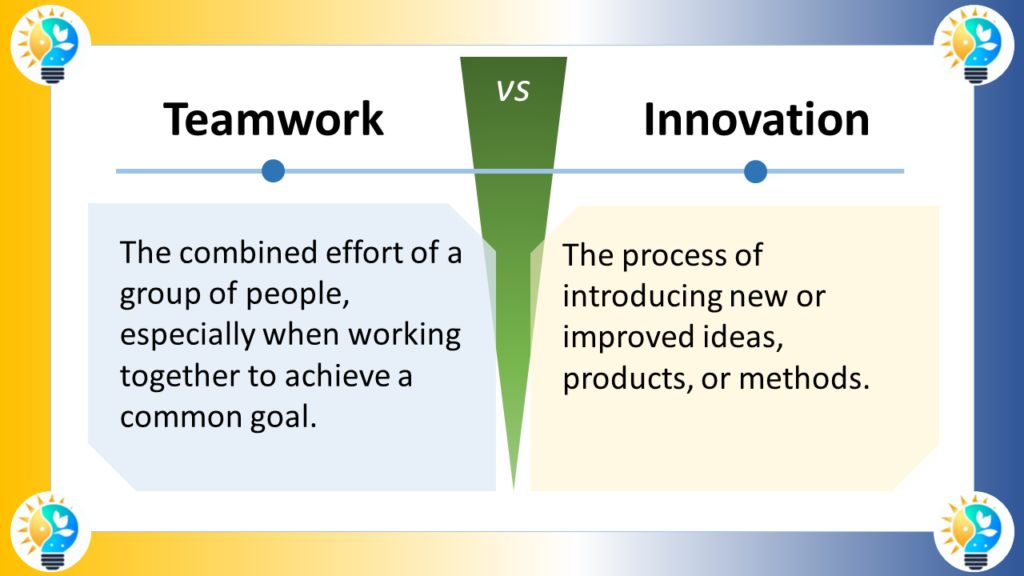Development generally refers to the process of improving or expanding upon existing ideas, products, or services. It often involves refining, optimizing, or enhancing something that already exists.
Innovation is the creation of something new, whether it’s an idea, method, or product. It involves introducing new ways of doing things, often disrupting the existing market or industry.
Definitions
The process of creating new ideas, products, services, or processes that add value to society.
Development
The process of improving the quality of life, economic growth, and social well-being of a nation or community.
More Synonyms on innovation, innovate and innovative
Innovation Terms

Innovation is considered as a driving force in progress.
It includes the introduction of novel ideas, methods, or products that bring positive change and advancement.
For more information about innovations, check our glossary
The Role of Innovation in Development
Innovation is the process of creating new ideas, products, services, or processes that add value to society. It is an essential ingredient for sustainable development as it helps to address complex social, economic, and environmental challenges. Innovation can lead to new technologies, products, and services that improve the quality of life, create jobs, and spur economic growth.
One of the most significant examples of innovation driving development is the digital revolution. The advent of the internet, smartphones, and other digital technologies has transformed the way we live, work, and communicate. It has created new industries, such as e-commerce, social media, and mobile banking, and has led to significant improvements in areas such as healthcare, education, and agriculture.
The Role of Development in Innovation
While innovation is a crucial driver of development, it is also essential to recognize the role of development in fostering innovation. A supportive policy environment, investment in research and development (R&D), and access to education and training are all critical factors that enable innovation to flourish.
Developing countries face unique challenges in fostering innovation, such as limited access to finance, lack of infrastructure, and a shortage of skilled workers. However, many developing countries are making significant strides in building innovation ecosystems that support entrepreneurship and R&D. For example, China has become a global leader in innovation, investing heavily in R&D and creating a supportive policy environment for startups.
Understanding the difference development and innovation
The difference between development and innovation lies in their focus and scope.
Development, often referring to research and development (R&D), is more about improving or creating new products and processes based on existing knowledge or technology. On the other hand, innovation is about driving new value and value streams, often involving the conception of entirely new ideas, products, or processes.
While R&D is more focused on incremental improvements and technological advancements, innovation is about making significant, often disruptive, changes.
In summary, R&D is about improving what you already have, while innovation is about creating something entirely new.
The following table summarizes the differences between development and innovation:
| Aspect | Development (R&D) | Innovation |
|---|---|---|
| Focus | Improving or creating new products/processes | Driving new value and value streams |
| Scope | Based on existing knowledge/technology | Can involve entirely new ideas, products, processes |
| Nature | Incremental improvements, technological advancements | Significant, often disruptive changes |
It's important to recognize that while these terms are similar in meaning, they can be vastly different in action. Both R&D and innovation are complementary and play a tremendous role in the success of any product or company[1][5].
The Importance of Collaboration and Partnerships
Collaboration and partnerships are critical to the success of innovation and development.
Governments, private sector companies, and civil society organizations must work together to create an enabling environment for innovation. This includes investing in R&D, providing access to finance, and creating policies that support innovation.
Collaboration between developed and developing countries is also essential for driving innovation and development. Developed countries can provide technical expertise, financing, and market access, while developing countries can offer unique insights and perspectives that can lead to new innovations. For example, the Global Alliance for Vaccines and Immunization (GAVI) is a public-private partnership that brings together governments, private sector companies, and civil society organizations to improve access to vaccines in developing countries.
Challenges and Opportunities
While the relationship between innovation and development is symbiotic, there are also challenges that must be addressed. One of the most significant challenges is ensuring that the benefits of innovation are equitably distributed. Innovation can lead to significant economic growth, but it can also exacerbate inequality if not managed properly.
Another challenge is ensuring that innovation is sustainable and does not harm the environment. As countries strive to improve the quality of life for their citizens, they must also consider the long-term impact of innovation on the planet. This requires a focus on sustainable innovation, which takes into account environmental, social, and economic factors.
Despite these challenges, there are also significant opportunities for innovation and development. Emerging technologies such as artificial intelligence, blockchain, and the Internet of Things (IoT) have the potential to transform industries and improve the quality of life for millions of people. By embracing innovation and fostering a supportive policy environment, countries can drive sustainable development and improve the well-being of their citizens.
Conclusion
In conclusion, innovation and development are intertwined and essential drivers of progress. Innovation can lead to new technologies, products, and services that improve the quality of life, create jobs, and spur economic growth. At the same time, development creates an enabling environment for innovation by investing in R&D, providing access to education and training, and creating policies that support entrepreneurship. By working together, governments, private sector companies, and civil society organizations can create a supportive ecosystem for innovation that drives sustainable development and improves the well-being of all citizens.


